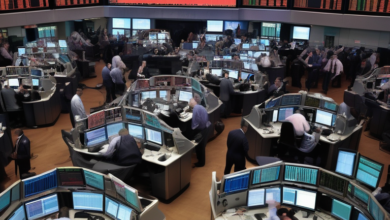Economic Worries Make Markets Close Much Lower: News Update August 1, 2024

Key Highlights
- The Dow Jones Industrial Average plummeted by nearly 500 points, marking its most significant single-day decline in 2024, fueled by resurfacing recession anxieties.
- Concerns about a potential economic downturn intensified due to weaker-than-anticipated manufacturing data and a rise in jobless claims.
- The S&P 500 recorded a decrease of 1.37%, concluding the day at 5,446.68.
- Concurrently, the Nasdaq Composite experienced a decline of 2.3%, settling at 17,194.15.
- Market apprehension regarding the Federal Reserve’s potential delay in implementing a rate cut before a potential economic downturn also contributed to the downturn.
What Caused the Market to Close Lower on August 1, 2024?
Investor mood fell on August 1, 2024. The stock market reacted to worried economic signs. There was weak data, like a worse ISM manufacturing index and more jobless claims. This made people anxious about a possible recession. Many wondered if the Federal Reserve might keep interest rates high for too long, which could hurt economic growth.
To add to the unease, the 10-year Treasury yield dropped under 4%. This was the lowest level since February and the lowest of this year. These changes made traders more worried. They worried the Fed might delay a rate cut, which could lead to a bigger economic downturn. All these factors caused a large sell-off, and the major stock market indices fell.
Overview of Major Index Closures on August 1, 2024
The stock market fell on August 1, 2024. Major indexes closed much lower. The Dow Jones Industrial Average had the largest drop, falling almost 500 points. It was the biggest loss in one day for the Dow in 2024. This decline shows how worried investors are about the economy.
The S&P 500 also went down by 1.37%. It ended the day at 5,446.68. The Nasdaq Composite also saw a drop, losing 2.3% to finish at 17,194.15. This market volatility shows how uncertain people feel about the economy’s future and what the Federal Reserve will do next.
Dow Jones Industrial Average Plummets: Key Factors
The Dow Jones Industrial Average fell sharply on August 1, 2024, losing almost 500 points. This big drop shows that there is lots of worry among investors about where the stock market is headed. Recently, Fed Chair Jerome Powell mentioned a possible interest rate cut in September. However, new economic data makes this less likely, which causes more ups and downs in the market.
Traders are worried about whether the Federal Reserve can help the economy “land softly.” The latest economic data suggests that the Fed’s raises in interest rates to control inflation might not be enough. This could mean they need to take bigger steps, which might harm economic growth.
The Dow’s drop is part of a larger trend in the stock market. Investors are dealing with ongoing uncertainty. With economic signs showing different trends, figuring out where the market will go in the next weeks and months is hard.
S&P 500 Ends Significantly Lower: Impact Analysis
The S&P 500 had a big drop on August 1, 2024. It closed a lot lower as fears of a possible recession made investors lose confidence. This drop happened after the index hit its highest level this year. People were hopeful for a smooth economic “soft landing” and thought the Federal Reserve might stop raising interest rates. But new economic data has made things more uncertain.
The bond market showed strain too. The yield on the 10-year Treasury note fell from its highest point last year. This drop means that many investors feel the Federal Reserve might soon finish its current cycle of raising rates. This belief is fueled by worries about an upcoming economic downturn.
The S&P 500’s drop shows how shaky market feelings can be with changing economic situations. The index has been strong this year, but worries about inflation, interest rates, and the risk of a recession are still affecting how investors act.
Sector-Specific Performance: Winners and Losers
During a day of crazy trading, different sectors performed in very different ways. While the market faced a lot of uncertainties, some sectors did better than others. The Utilities sector shone brightly and showed strong resilience during this tough time.
On the other hand, Technology stocks struggled. The tech-heavy Nasdaq Composite went down. Major companies in the Artificial Intelligence (AI) area felt the pressure too. This was due to profit-taking after seeing big gains earlier in the year.
Technology Stocks Take a Hit: Major Companies Affected
Technology stocks, known for their growth and sensitivity to interest rates, faced challenges on August 1, 2024. This led to a drop in the Nasdaq Composite, showing how vulnerable the sector is during uncertain times.
Even though Meta Platforms had better-than-expected earnings this past quarter, its stock price fell. This may indicate that investors are worried about what will happen next with the company. Increased competition and stricter regulations could be playing a role in these fears.
However, some tech companies remained strong despite the overall decline. For instance, Nvidia, a key player in the AI field, saw a drop in its stock price. This might be due to investors cashing in on their profits after a great run earlier this year.
The performance of tech stocks shows how much they depend on the economy and investor feelings. As the year goes on, factors like changes in interest rates, inflation, and corporate earnings will likely have an impact on this important sector.
Utilities Sector Shows Resilience Amid Market Turbulence
The Utilities sector showed strong strength despite the ups and downs of the market. It offered a different story compared to the decline seen in the wider market. This sector is known for its steady earnings and good dividend payments. It often attracts investors looking for safety when things get tough. This was especially true on August 1, 2024, when investors worried about the overall economy began to favor utility stocks for their sense of security.
Utilities play a crucial role because they are necessary and have stable pricing. They bring some certainty to a market that can be hard to predict. This certainty is very attractive when economic growth seems to be shaky.
As investors face tough choices in today’s market, the Utilities sector stands out as a possible safe place for their money. Its ability to give steady returns, mainly through dividends, makes it eye-catching. This can pull in people who want stability and steady income while the market remains volatile.
Company Highlights: Earnings and Forecasts
Corporate earnings reports released on August 1, 2024, presented a mixed bag, with some companies exceeding expectations while others faced challenges. Tesla, the electric vehicle manufacturer, surprised analysts with its strong second-quarter earnings. Conversely, Amazon, the e-commerce behemoth, grappled with a more subdued outlook, raising concerns among investors about its future growth trajectory.
Here’s a quick snapshot of the company earnings and forecasts:
|
Company |
Earnings per Share |
Revenue |
Outlook |
|
Tesla |
Exceeded expectations |
Strong Second Quarter |
Positive |
|
Amazon |
Met expectations |
In line with estimates |
Challenging |
Tesla’s Quarterly Earnings Surpass Expectations
Tesla surprised everyone by reporting better earnings than expected for the second quarter of 2024. The electric vehicle maker, led by CEO Elon Musk, showed it can cope in a tough economy with high prices and supply chain issues.
The company’s revenue for the quarter was higher than what analysts expected. This came from strong demand for its electric vehicles. Tesla’s focus on new ideas and increasing production helped it meet the rising need for electric cars around the world.
These good results stand out against the overall market decline. They give investors confidence in Tesla’s growth and its ability to handle challenges in the economy. As the electric vehicle market keeps growing, Tesla looks ready to stay at the front of the industry.
Amazon Faces Challenges: A Closer Look at Its Forecast
Amazon’s earnings in the second quarter matched what the market expected. However, the company’s future outlook looks more careful, which has worried investors about its growth. Although Amazon reported revenue that met expectations for the quarter, it admitted to facing issues from ongoing inflation and changes in how people shop. These factors might affect how well it does in the future.
The e-commerce leader has been the top player in online retail for a long time. Now, it is facing stronger competition from its rivals and changes in consumer habits since the pandemic. As people rethink how they spend their money during tough economic times, spending on non-essential items, which is important for Amazon, may slow down.
Considering these difficulties, Amazon’s cautious forecast makes sense. The company is dealing with a fast-changing environment with many economic and competitive challenges. Investors will be paying close attention to how Amazon changes its strategies and whether it can keep its leading position despite these hurdles.







